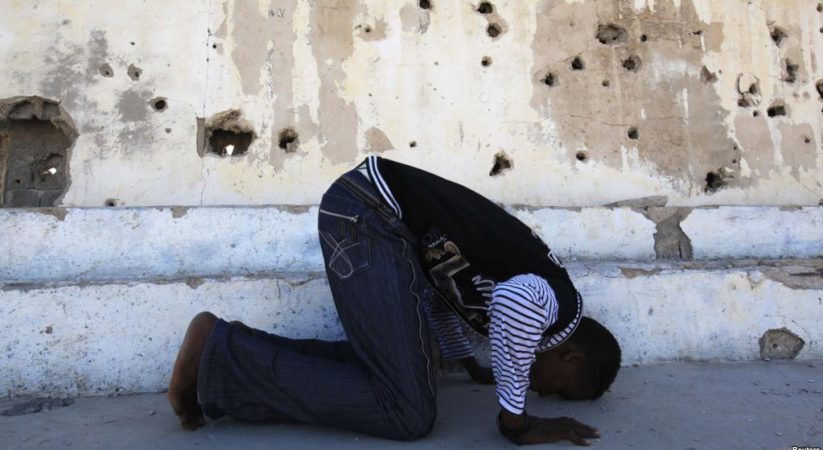
FILE – Somali athlete Abdullah Bare Kuulow prays after a training session in preparation for the 2012 London Olympic Games inside Mogadishu Stadium, March 16, 2012. AFRICOM troops have relocated from the complex, returning its main focus to athletics.
VOA | August 29, 2018 | Mohamed Olad Hassan – The African Union Mission in Somalia (AMISOM) has withdrawn from Mogadishu’s largest sports village, vacating what once served as a main training base for Islamist militants and returning the site’s focus to athletics.
“We are extremely happy that African Union troops have finally heard the youth requests for vacating the national stadium so it can be used again for sports events,” Khadiijo Mohamed Diirie, minister of youth and sports, said at a handover ceremony Tuesday.
She also announced the government’s plans to start rebuilding the war-damaged complex “to contribute to the country’s sports, peace and youth integration.”
Somali President Mohamed Abdullahi Mohamed said the government would spare no effort on the restoration “in order for Somalia to regain its sporting status in Africa and at the international level.”
The sports village, known as Mogadishu Stadium, is the largest in the Horn of Africa nation. Its stadium has capacity for 65,000 people.
At least 1,200 of AMISOM’s 22,000 troops had been stationed at the complex, but they were relocated to some 20 other bases around the country to bolster military operations against al-Shabab militants.
The complex, built by Chinese in the 1970s, has witnessed less athletic competition than military training and armed combat. When civil war broke out in 1991, militia moved in. The site served as a base for various armed groups, including al-Shabab militants who recruited and trained there in 2006. They were dislodged by U.S.-backed Ethiopian troops who supported the Somali government, but returned after the troops’ 2009 withdrawal. African Union forces drove out the militants from the capital in 2011.
Hundreds of combatants have died in fighting in and near the complex, according to Somali government officials and human rights groups’ records.
Checking out grounds
On Tuesday, hundreds of jubilant young people trooped into the complex to see its sports fields, swimming pools and other recreational facilities for the first time in seven years.
Some voluntarily began cleaning the grounds, littered in some places with spent bullets and the remains of disabled rocket-propelled grenades.
“I was 13 years old when I last set my foot on this field, and now after seven years I am back,” said Zakariye Hassan, one of the visitors. “I was going to a faraway sports field while this stadium is only two blocks from my house.”
As security improves in Mogadishu, demand for access to the facility has grown. Many young athletes and local and national sports groups hope to train there.
“I started my training here before joining a first division soccer team, but for many years we have been deprived off our rights to exercise, compete and train here,” said Saa’id Ahmed, a soccer coach for the Wardhigley District soccer team. “Finally, we are happy to get it back.”
The Somali Football Federation announced in 2017 that it expected to begin hosting international games this year. “Due to the betterment of the security situation in Somalia, we have decided to stage our home games at home,” the federation’s president, Abdiqani Said Arab, said in a statement at the time.
AMISOM also recently vacated the Somali National University, which had been a base for its Burundi contingent for the last 10 years.
.
.
.
Xafiiska Wararka Qaranimo Online | Muqdisho
____________________________________________________
_____________________________________________________________________________________
Xafiiska Wararka Qaranimo Online | Mogadishu, Somalia
_____________________________________________________________________________________Advertisement
_____________________________________________________________________________________





